Department Of Defense Eyeing Retrofit Metal Roofing For Thousands Of Buildings
| | 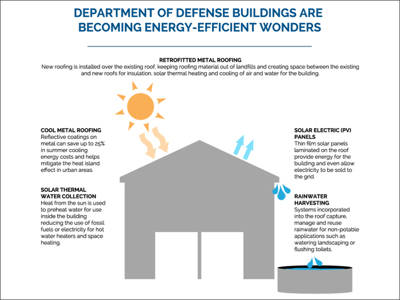 |
| | Infographic and accompanying images provided by the Metal Construction Association. Click to enlarge. |
MCA Teams With Oak Ridge National Laboratory To Create Demonstration Project At Goodfellow Air Force Base In Texas
Chicago, IL – The nation’s largest energy user, the Department of Defense (DoD), is learning how to transform some of its 577,500 buildings and structures into state-of-art energy-saving powerhouses, by retrofitting old buildings with new high-tech roofing systems. In partnership with the Metal Construction Association (MCA) and the Department of Energy’s Oak Ridge National Laboratory, the DoD is host to a demonstration project for reducing a building’s carbon footprint and lowering demand for energy and water. The demonstration project was part of the DoD’s Strategic Environmental Research and DevelopmentProgram (ESTCP) at Goodfellow Air Force Base (GAFB) in San Angelo, Texas. The model will be replicated at potentially thousands of DoD buildings throughout the country.

| |
Retrofit metal roof systems can be installed right over the old roof, saving time, limiting the disruptions to the day-to-day activities of building occupants, and eliminating the volume of materials taken to landfills. |
|
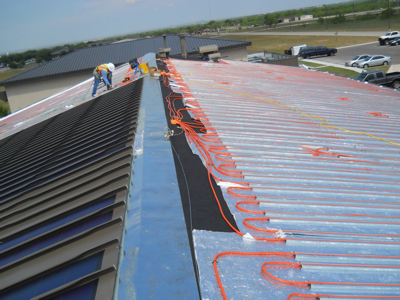
| |
The retrofit metal roof system comprises several energy-saving technologies working in unison. | |

| |
The completed retrofit metal roof system at Goodfellow Air Force Base will serve as a model for potentially thousands of future DoD projects throughout the country. | |
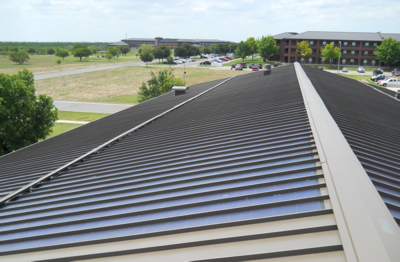
| |
The photovoltaic system employed was a "self-adhered" thin-film amorphous silicon BIPV laminate that was applied directly to the flat panel portions of the new metal roof panels. | |
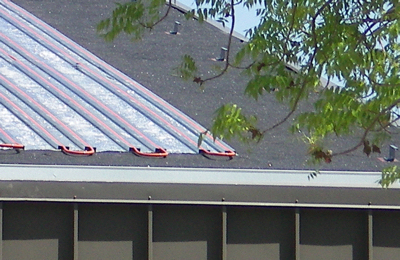
| |
Solar thermal water collection is facilitated by a grid of water-filled tubing laid out on the old roof before installation of the new metal system. | |
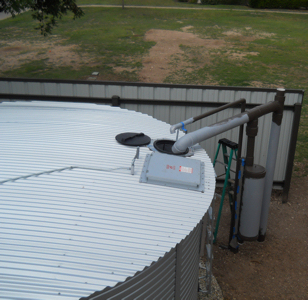
| |
The new metal roof system includes a subsystem that harvests, manages and re-uses rainwater runoff from the roof for non-potable applications such as watering landscape and flushing toilets. | |
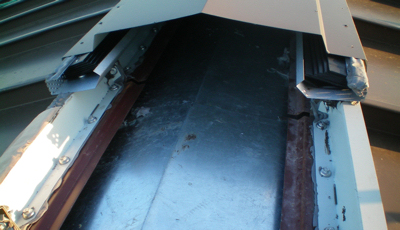
| |
The new metal roof was installed over the existing roof, creating a cavity for insulation, solar thermal heating systems and cooling of air and water for the building. | |
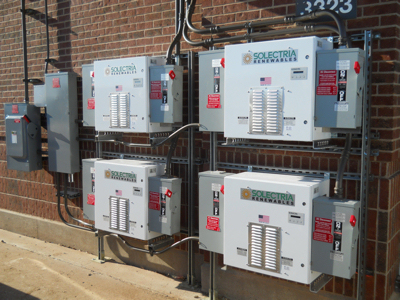
| |
Solar panels on the roof provide energy for the building and even allow electricity to be sold to the electric utility. | |
“We are thrilled to see this technology come together. Both the MCA and DoD see a great benefit to the broader U.S. economy when new and retrofit buildings throughout the country adopt this high performance roofing design, and work toward net-zero energy buildings,” says Scott Kriner, Technical Director, Metal Construction Association.
The dynamic roofing system was installed at the Security Forces Building at GAFB and performs many functions, using a combination of technologies that heat and cool air and water, produce electricity, and collect rainwater. The metal roof retrofit system can be installed over an existing roof, saving installation costs and keeping old roofing material out of landfills. What makes this roofing system unique is that it brings together multiple functions in one holistically designed, integrated building envelope system that can be used on flat or sloped roof designs.
The technology used is a hybrid of metal roofing, insulation, hydronic solar thermal systems, engineered air pathways, and photovoltaic (PV) cells, all designed to work symbiotically. This high performance system includes a retrofitted metal roof installed over the existing roof, which creates a cavity between the existing and new roofs. Within that cavity insulation, solar thermal heating systems and cooling of air and water for the building can be installed. More specifically, the technologies incorporated into the metal roof system are:
1) Cool metal roofing: high solar reflectance coatings on metal save up to 25% in summer cooling energy costs and helps mitigate the heat island effect in urban areas.
2) Solar thermal water heating: sun is used to preheat water for use inside the building, reducing the use of fossil fuels or electricity for hot water heaters. The heated water can also be used for space heating using a heat exchanger.
3) Rainwater harvesting: this subsystem harvests, manages and reuses rainwater for non-potable applications such as watering landscaping or flushing toilets.
4) Solar electric (PV) panels: thin film solar panels laminated on the roof provide energy for the building and even allow electricity to be sold to the grid.
With the roofing system installation at GAFB, the Department of Defense and the Metal Construction Association are demonstrating how integrating energy efficiency and solar technologies with a retrofit metal roofing system can reduce energy and water consumption, mitigate the building’s environmental impact, and lower construction and operating costs.
About The Metal Construction Association
 The Metal Construction Association brings together a diverse industry for the purpose of expanding the use of metal in construction through marketing, research, technology, and education. Companies involved in MCA benefit tremendously from association
activities that focus on research, codes and standards, market development, and technical programs. MCA’s market development efforts increase the use of metal in construction by educating the building and design communities about the benefits
of metal. For more information about MCA, visit www.metalconstruction.org.
The Metal Construction Association brings together a diverse industry for the purpose of expanding the use of metal in construction through marketing, research, technology, and education. Companies involved in MCA benefit tremendously from association
activities that focus on research, codes and standards, market development, and technical programs. MCA’s market development efforts increase the use of metal in construction by educating the building and design communities about the benefits
of metal. For more information about MCA, visit www.metalconstruction.org.



